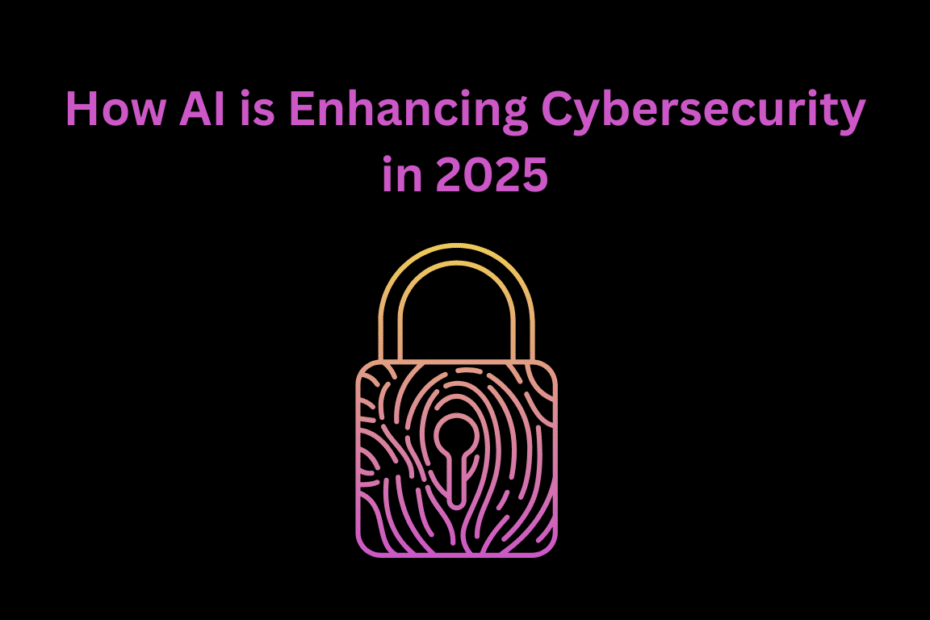Cybersecurity threats are growing more advanced by the day, and in 2025, traditional defenses are no longer enough. The rise of artificial intelligence (AI) has fundamentally changed the cybersecurity landscape—giving both defenders and attackers new tools to work with. However, when used ethically and strategically, AI is proving to be a game-changer in protecting digital infrastructures, data, and systems.
In this blog, we’ll explore how AI is enhancing cybersecurity in 2025, the key technologies behind it, the benefits it offers, and what the future holds.
Why AI is Crucial in Today’s Cybersecurity
Cybersecurity experts are overwhelmed by the sheer number of threats. According to recent industry reports, over 350,000 new malware variants are created daily. It’s impossible for human analysts to keep up. That’s where AI steps in.
AI can automate threat detection, analyze massive datasets in real-time, predict potential vulnerabilities, and respond faster than any human could. It learns from patterns, improves over time, and becomes smarter with every new threat it encounters.
Key Areas Where AI is Enhancing Cybersecurity
1. Threat Detection and Prediction
AI-powered systems in 2025 are capable of identifying threats long before they cause damage. By analyzing behavioral patterns, network traffic, and system anomalies, AI can detect potential cyberattacks—such as phishing attempts, ransomware, or insider threats—at lightning speed.
Machine learning (ML) algorithms are especially useful in zero-day attack detection, where conventional antivirus tools fail. These AI models are trained on massive datasets to recognize even the subtlest signs of an emerging threat.
2. Automated Incident Response
Speed matters in cybersecurity. When a breach occurs, response time is critical. AI-driven systems in 2025 can automatically respond to incidents without human intervention. They can isolate compromised endpoints, block malicious IP addresses, and even initiate a system rollback to prevent data loss.
This level of automation reduces the time between detection and response from hours or days to mere seconds, minimizing the potential damage.
3. Behavioral Biometrics and Authentication
Traditional passwords and two-factor authentication are no longer enough. AI is now being used to develop more advanced authentication systems based on behavioral biometrics—such as typing patterns, mouse movements, and mobile usage behaviors.
By constantly learning how a user interacts with a device, AI systems can spot unauthorized access attempts even if the credentials are correct. This helps prevent account takeovers and identity theft.
4. Real-Time Network Monitoring
In 2025, AI systems are continuously scanning networks for signs of suspicious activity. They don’t just flag anomalies—they prioritize threats based on risk level and business impact.
This allows cybersecurity teams to focus on what matters most, rather than getting buried in low-priority alerts. AI also correlates multiple data sources—logs, endpoints, applications—to get a holistic view of the network health.
5. AI-Powered Phishing Detection
Phishing attacks have become more sophisticated, especially with the rise of deepfakes and generative AI. Fortunately, AI is fighting back. Email filters powered by AI can now understand the context and tone of messages, not just keywords.
Natural Language Processing (NLP) models analyze the sender’s behavior, writing style, and domain history to determine whether an email is suspicious. This helps organizations stop phishing attacks before employees even open the messages.
Benefits of Using AI in Cybersecurity
- Faster Response Time: AI dramatically reduces the time taken to detect and neutralize threats.
- Scalability: AI tools can protect vast networks and cloud infrastructures without additional human resources.
- Accuracy: Machine learning reduces false positives, ensuring analysts focus only on real threats.
- Cost-Efficiency: AI automates repetitive tasks, allowing teams to operate more efficiently and reduce costs.
- Continuous Learning: AI systems evolve with time, becoming smarter and more capable of handling new attack methods.
Challenges of AI in Cybersecurity
Despite its advantages, AI also presents challenges. Cybercriminals are using AI to launch more complex attacks—automating malware development, deepfake impersonations, and even AI-generated phishing campaigns.
Moreover, AI models are only as good as the data they’re trained on. If the data is biased or incomplete, the system may make incorrect decisions. There’s also the ethical concern of over-relying on AI without adequate human oversight.
Future of AI in Cybersecurity
Looking ahead, AI will play an even bigger role in cybersecurity. Emerging trends include:
- AI + Blockchain: Combining AI with blockchain for secure data sharing and validation.
- Explainable AI (XAI): Creating transparent AI systems where decisions can be understood and trusted by humans.
- Quantum-Resistant AI: Preparing for the potential threats posed by quantum computing.
- Cybersecurity-as-a-Service: AI-driven platforms offering end-to-end protection for small businesses.
AI won’t replace cybersecurity professionals, but it will empower them to work faster and smarter in a rapidly evolving digital world.
Conclusion
In 2025, AI isn’t just a helpful tool—it’s a necessity in the fight against cybercrime. From proactive threat detection to instant incident response, AI is revolutionizing how we protect our digital lives. Organizations that embrace AI-powered cybersecurity are better equipped to stay one step ahead of hackers in an increasingly complex cyber landscape.
As cyber threats continue to evolve, so must our defenses—and with AI on our side, the future of cybersecurity looks more resilient than ever.
Read More: AI Automation: Refine Business Processes Efficiently
FAQs
1. How does AI help detect cyber threats?
AI uses machine learning to identify patterns and anomalies in data, enabling it to detect potential threats in real-time—even those that haven’t been seen before.
2. Can AI stop phishing attacks?
Yes. AI-powered email filters use natural language processing and behavioral analysis to detect suspicious emails and block phishing attempts.
3. Is AI used for user authentication?
Absolutely. AI enhances authentication through behavioral biometrics, such as typing rhythm and device usage patterns, offering stronger protection than traditional passwords.
4. What are the limitations of using AI in cybersecurity?
AI models can be biased, require large amounts of quality data, and may be vulnerable to adversarial attacks if not properly secured.
5. Will AI replace cybersecurity jobs?
No. AI will automate repetitive tasks but still requires human oversight for strategy, decision-making, and ethical considerations.

